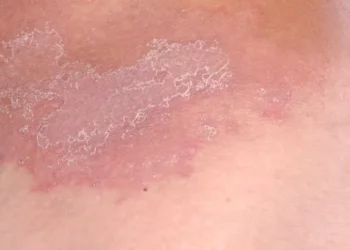Ringworm is a common fungal infection that can appear anywhere on the body. Despite its name, it is not caused by a worm but by fungi. The infection gets its name from the ring-like rash that it creates on the skin. In this article, we will explore the causes of ringworm around the body, how it spreads, its symptoms, and the treatment options available.
Understanding Ringworm
Ringworm is a fungal infection that affects the skin, hair, and nails. It is caused by a group of fungi called dermatophytes. These fungi thrive in warm, damp environments and feed on keratin, the protein found in skin, hair, and nails. The infection is highly contagious and can spread through direct contact with an infected person or by touching contaminated surfaces.
Ringworm is often seen as a red, itchy rash with a raised, scaly border. The skin in the center of the rash may appear normal or slightly scaly, giving the infection its ring-like appearance. The rash can occur anywhere on the body, including the scalp, feet, groin, and nails. It can also affect pets, particularly cats and dogs, and be transmitted to humans.
What Causes Ringworm?
Ringworm is caused by fungi that infect the outer layer of the skin. These fungi, called dermatophytes, include species such as Trichophyton, Microsporum, and Epidermophyton. These fungi can be found in many environments, such as soil, on animals, and on humans. They thrive in warm, moist areas like locker rooms, public swimming pools, and gyms. They can also grow in damp clothing and shoes.
The main cause of ringworm is exposure to these fungi, which can occur through direct contact with infected people or animals. The infection can also spread by touching contaminated surfaces or objects like towels, combs, or clothing. Fungi can live on these surfaces for days or even weeks, making it easy to catch the infection without realizing it.
How Ringworm Spreads
Ringworm is highly contagious and can spread easily in several ways:
Direct Skin-to-Skin Contact: The most common way ringworm spreads is through close contact with an infected person. It can be transmitted when someone touches the rash or shares items like clothing, towels, or bedding that have come into contact with the infection.
Contact with Infected Animals: Pets, especially cats and dogs, can carry the fungi that cause ringworm. If a person touches an infected animal or its fur, they can develop ringworm. It is also possible to catch the infection from livestock or farm animals.
Contaminated Surfaces and Objects: Fungi that cause ringworm can live on surfaces like floors, shower stalls, and swimming pool areas. Using contaminated towels, brushes, or even touching infected furniture can lead to an infection. Public places like gyms and swimming pools are common areas where the fungi spread.
Environmental Factors: The fungi thrive in warm and humid environments, making it easier for them to spread in areas such as locker rooms, showers, and gyms. People who sweat a lot or live in hot, humid climates are at higher risk of developing ringworm.
Who Is at Risk of Getting Ringworm?
Certain factors increase the likelihood of developing ringworm. These include:
Close Contact with Infected Individuals: People who live in close quarters with others, such as dormitories, nursing homes, or daycare centers, are more likely to contract ringworm from infected individuals.
Pets: Those who have pets, particularly cats and dogs, may be at a higher risk of getting ringworm, as animals can carry the fungi.
Weakened Immune System: People with a weakened immune system due to conditions like diabetes, HIV/AIDS, or cancer are more susceptible to fungal infections, including ringworm.
Excessive Sweating: People who sweat heavily, either due to physical activity or certain medical conditions, are more likely to develop ringworm, as fungi thrive in warm, moist environments.
Wearing Tight Clothing: Wearing tight, non-breathable clothing can trap sweat and moisture against the skin, creating an ideal environment for fungi to grow and spread.
Symptoms of Ringworm Around the Body
Ringworm symptoms vary depending on where the infection occurs on the body. However, the most common symptoms include:
Itchy Rash: The most noticeable symptom of ringworm is a red, itchy rash that may appear in a ring-like shape. The skin in the center may appear normal or scaly, while the edges of the rash may be raised and have a distinct border.
Scaly Skin: The infected area may become dry and flaky, and the skin may begin to peel or crack.
Blisters: In some cases, blisters may form around the ring-like rash, which can be painful and may ooze pus.
Inflammation and Redness: The skin around the rash may become inflamed and red. In more severe cases, the infection can spread to other areas of the body.
Hair Loss: When ringworm affects the scalp, it can lead to hair loss or patches of baldness where the infection is present.
Thickened Nails: If ringworm affects the nails, they may become thickened, discolored, and brittle. In severe cases, the nails may separate from the nail bed.
How to Prevent Ringworm
Preventing ringworm involves avoiding contact with infected people, animals, and contaminated objects. Here are some helpful tips to reduce the risk of developing ringworm:
Practice Good Hygiene: Wash your hands regularly and clean any areas that may be contaminated, such as shower stalls, gym equipment, and shared surfaces.
Keep Skin Dry: Since fungi thrive in moist environments, it is important to keep the skin dry, especially after sweating. Make sure to dry off thoroughly after bathing or swimming.
Avoid Sharing Personal Items: Do not share items such as towels, clothing, or combs with others. Always use your personal items, especially in public areas.
Wear Protective Clothing: When using public showers or swimming pools, wear flip-flops or sandals to protect your feet from contact with contaminated surfaces.
Treat Pets for Ringworm: If you have pets, take them to the vet for regular check-ups and treat them promptly if they show signs of ringworm.
Treatment for Ringworm
Ringworm is treatable, and several options are available to help clear the infection:
Topical Antifungal Creams: Over-the-counter antifungal creams, such as clotrimazole, miconazole, and terbinafine, are often effective in treating mild cases of ringworm. These creams should be applied directly to the affected area for the recommended duration, usually 2 to 4 weeks.
Oral Antifungal Medications: In more severe cases, oral antifungal medications may be prescribed by a doctor. These medications are usually taken for several weeks and help eliminate the infection from the inside out.
Medicated Shampoos: For ringworm on the scalp, medicated shampoos containing antifungal agents like ketoconazole or selenium sulfide may be recommended. These shampoos can help reduce the spread of the infection and speed up recovery.
Home Remedies: While not as scientifically proven, some people find relief from ringworm using home remedies like tea tree oil, coconut oil, or apple cider vinegar. These remedies have antifungal properties, but it is best to consult with a healthcare professional before trying them.
When to See a Doctor
If you have a persistent or severe case of ringworm, or if it spreads to large areas of the body, it is important to consult a healthcare provider. A doctor may prescribe stronger antifungal treatments or perform tests to determine the cause of the infection.
If the infection does not improve with over-the-counter treatments, or if it affects sensitive areas such as the face or genitals, seek medical attention as soon as possible.
Conclusion
Ringworm is a common and treatable fungal infection that can cause red, itchy rashes in a ring-like shape. It is caused by fungi that thrive in warm, damp environments and can spread through direct contact with infected individuals, animals, or contaminated surfaces. While ringworm is not a serious condition, it can be uncomfortable and unsightly. With proper hygiene, preventive measures, and treatment, ringworm can be effectively managed and prevented. If the infection persists or worsens, consult a healthcare provider for professional treatment.
Related topics



























